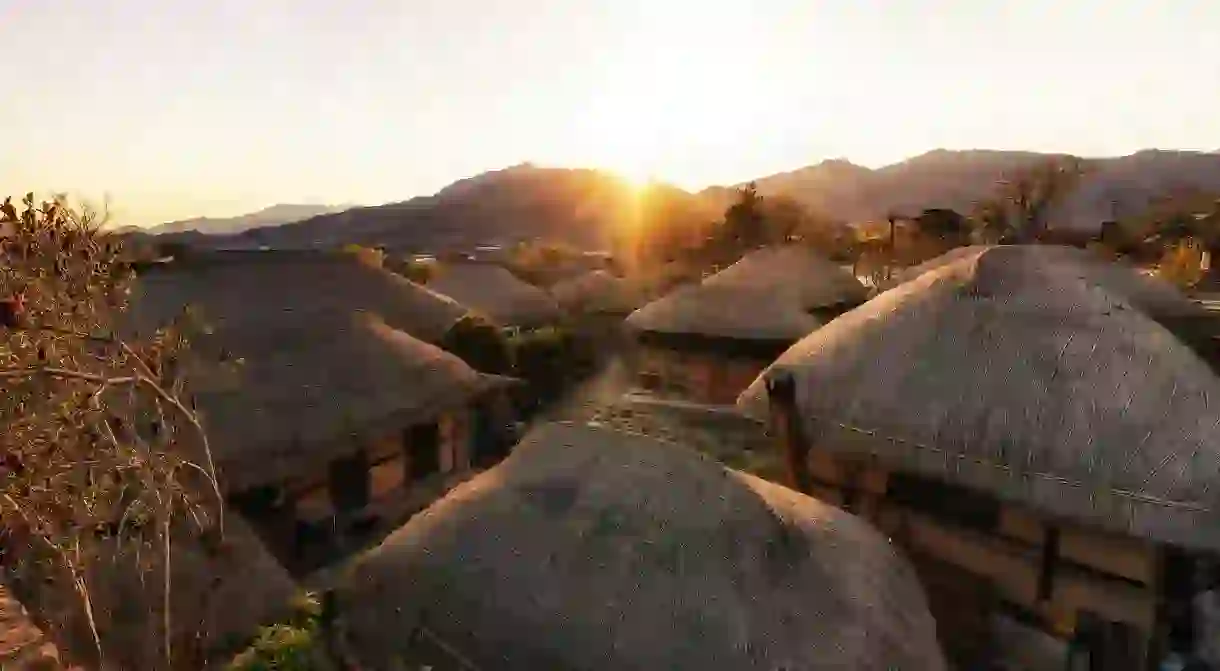Incredible Rural Destinations in South Korea

Much of the Korean travel experience is defined by the hustle and bustle of the country’s sprawling metropolises. But for those willing to venture beyond the city limits into South Korea’s rural destinations, unique cultural encounters, regional culinary specialties and stunning natural landscapes await. Here are five towns and villages to add to your itinerary.
Explore Andong, Korea’s folk capital
Known as the birthplace of soju, wooden masks and Confucianism in Korea, Andong provides visitors with the unique opportunity to immerse themselves in Joseon-era rural life.
Of the town’s attractions, the 600-year-old, UNESCO-listed Hahoe Folk Village is its most popular. Nestled on the picturesque Nakdong River, the village boasts dozens of beautifully preserved choga (traditional thatched-roof homes), many of which are still lived in. Others function as guesthouses, artisan workshops and restaurants serving up jjimdak (a slurp-worthy braised chicken and vegetable stew in a soy sauce-based broth).
Every fall, Andong hosts the Maskdance Festival to celebrate the town’s folk traditions including talchum (a form of satirical storytelling through dance in which the participants wear wooden masks). The Hahoe Mask Museum offers additional insight into the masks as well as the storylines of the various dances.
Get a breath of fresh air in Damyang
The county and town of Damyang in Jeollanam-do Province has a lot to offer those eager to explore Korea’s rural idylls. There’s an ancient fortress, a handful of visit-worthy temples and delicious local cuisine. Don’t miss the tteokgalbi (grilled rib patties) and daetong bap (rice steamed in bamboo).
But the real draw of Damyang is its nature-centric attractions. Juknokwon Bamboo Forest, a vast network of lush bamboo groves connected by eight trails, invites visitors to enjoy a relaxing stroll and the health benefits of forest bathing. The grove is also the site of the Bamboo Festival, a celebration of all things related to the tree, every May.
Nearby, Metasequoia Road, an 8.5-kilometre-long (5.3-mile) street flanked by redwoods, is the ideal walking or cycling path to take in Damyang’s charming scenery, which transforms entirely from season to season.
Enjoy bucolic landscapes in Hadong
One of Korea’s most rural and off-the-beaten path destinations is Hadong, a small farming community nestled alongside the Seomjin River in the valley of Jiri Mountain.
Hadong’s proximity to Jirisan National Park makes it a wonderful base for hikers and campers, not to mention an idyllic setting for those seeking stunning natural views. In the spring, when the hillsides come to life with colourful trees and flowers, the town hosts its Maehwa Festival. Here, locals partake in activities to celebrate the end of winter and revel in the hope that the months to come will be as majestic as the plum flower for which the festival is named.
For a bit more solitude, consider a visit to the quaint Hannsansa Temple, which offers an incredible view of Hadong’s rice fields. Or, pay a visit to one of the town’s tranquil tea houses where you can savour the flavours of locally grown green tea while enjoying the slow pace of rural life.
Get a peek into the past in Namhae
Situated off the mainland’s southern coastline, Namhae dazzles with its sandy beaches, unexpected attractions and stunning landscapes that have earned it the nickname: “Treasure Island of Korea”.
Areas of interest include German Village, an enclave built to invite back and provide subsidies for Koreans who were sent to work in Germany by the government during the 1960s and ’70s, a time of economic strife for the country. The village features cobblestone streets, German-style architecture, German restaurants and even an annual Oktoberfest.
For a taste of traditional Korean village life, a visit to Daraengi Village is a must. Beloved for its picturesque rice terraces that cascade down a steep coastal cliff, Daraengi is one of the few places in the country where traditional farming methods are still employed. Opt to participate in one of the village’s cultural activities such as harvesting rice, fishing or ssireum (Korean wrestling).
Experience an unspoiled ecological retreat in Suncheon
As a habitat for a wide variety of plant and animal life, Suncheon has been globally recognised for its ecological value, and is often referred to as the ecological capital of Korea – not to mention it’s one of the most beautiful coastal areas in the country.
The crown jewel of the town is the Suncheon Bay Wetland Reserve, one of the largest tidal flats in the world. It’s home to the largest colony of reeds in Korea and is also an important area for migratory birds including the rare hooded crane. Don’t miss the observation deck, which offers wildly impressive views of the reserve.
Other highlights of Suncheon include temples Seonamsa and Songgwangsa; Naganeupseong, a village of thatched roof houses that date back to the Joseon Dynasty and Suncheon Bay National Garden, an expansive conservation area featuring art exhibits, performances and more than 600 species of plants. The Suncheon City Tour makes stops at all of these attractions, offering a convenient way to see the best of the area.













